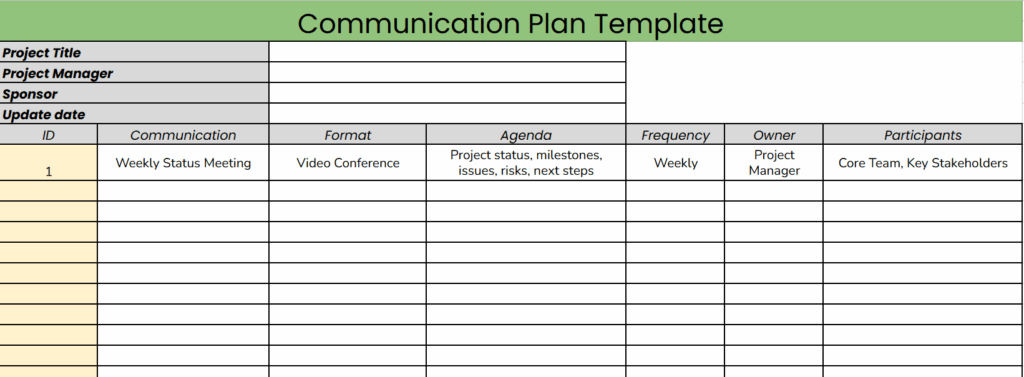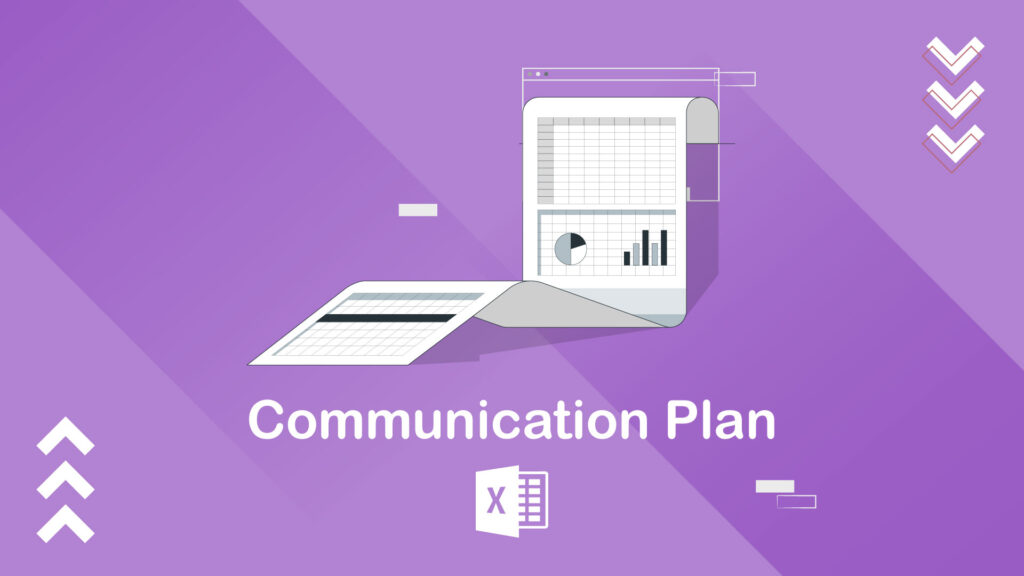1. Introduction
Communication is the heartbeat of every successful project. Without clear, timely, and effective communication, even the best-planned projects can fall apart. In fact, according to the PMI’s Pulse of the Profession report, poor communication is a primary reason for project failure. Moreover, communication gaps lead to misaligned expectations, duplicated efforts, and reduced team morale. When team members, clients, and stakeholders don’t receive the right information at the right time, decision-making becomes flawed, and project success is jeopardized.
2. What Is a Communication Management Plan?
A Communication Management Plan outlines how project information is collected, structured, and shared. It ensures stakeholders receive timely and relevant updates.
According to the PMBOK® Guide, communication is critical to every phase of a project. In fact, poor communication is one of the top reasons for project failure.
As a Project Manager , I always emphasize building a solid communication plan early. It serves as a blueprint for how the team will collaborate throughout the project lifecycle.

3. Why a Communication Plan Is Critical for Project Success
Communication is the lifeblood of project management. It links strategy, execution, and stakeholder engagement.
An effective communication plan offers numerous benefits, including:
- Improved stakeholder engagement: Regular updates keep stakeholders invested and informed.
- Enhanced transparency: Open communication fosters trust and alignment.
- Fewer misunderstandings: Clear messaging reduces the risk of confusion.
- Better decision-making: Timely data leads to more informed actions.
- Increased accountability: Defined responsibilities ensure tasks are completed as expected.
Without a clear plan:
- Tasks are misunderstood.
- Decisions are delayed.
- Stakeholders lose trust.
4. Key Elements of an Effective Communication Plan
A solid communication plan doesn’t just outline how people talk—it defines who talks to whom, when, and how.
4.1 Objectives & Goals
A communication plan must begin with clearly defined objectives. Ask yourself: What is the purpose of our communication? Is it to inform, request action, escalate issues, or gain feedback?
Key objectives may include:
- Keeping stakeholders aligned on progress
- Managing expectations across teams
- Facilitating quick decision-making
- Documenting key discussions and changes
It is essential to align communication goals with overall project objectives. For instance, if the project goal is rapid deployment, your communication should prioritize agility, real-time updates, and brief reports.
4.2 Stakeholder Analysis
Not every stakeholder needs the same information at the same frequency. Begin by identifying all stakeholders:
- Internal: Project team, sponsors, department heads, QA teams
- External: Clients, vendors, consultants, regulatory bodies
Next, use a power/interest matrix to classify them:
| Stakeholder | Power | Interest | Communication Need |
|---|---|---|---|
| Project Sponsor | High | High | Weekly Executive Summary |
| Developers | Medium | High | Daily Stand-ups, Task Updates |
| Clients | High | Medium | Bi-weekly Reports, Feedback Calls |
| QA Team | Low | Medium | Testing Schedules & Bug Reports |
This analysis ensures you communicate the right message to the right people.
4.3 Communication Methods & Channels
Selecting appropriate communication channels is essential for efficiency and clarity. Consider the nature, urgency, and formality of the message:
- Meetings:
- Daily stand-ups (Agile teams)
- Weekly progress reviews
- Monthly steering committee meetings
- Emails: Best for formal updates, decisions, or summarizing meeting outcomes.
- Reports & Dashboards: Useful for visualizing KPIs and project status.
- Collaboration Tools:
- Slack or MS Teams for real-time messaging
- Asana, ClickUp, or Jira for task tracking
Each channel has its strengths. Use them strategically depending on the context.
4.4 Frequency & Timing
It is not just what you say but when you say it that matters. Define communication cadence:
- Regular:
- Daily team huddles
- Weekly status reports
- Monthly executive briefings
- Ad-hoc:
- Crisis communications
- Unexpected changes or risks
Ensure critical milestones and deliverables are accompanied by timely updates. Avoid over-communication that leads to fatigue or information overload.
4.5 Roles & Responsibilities
Define who is responsible for crafting, sending, and approving each type of communication. Using a RACI matrix helps eliminate confusion:
| Communication Task | Responsible | Accountable | Consulted | Informed |
| Weekly Project Report | PM | PMO | Team Leads | Stakeholders |
| Client Status Meeting | PM | PM | Account Manager | Dev/QA Leads |
| Escalation Notification | PM | Sponsor | Risk Manager | Project Team |
This structure promotes clarity and ownership.
4.6 Message Content & Format
Standardize your communication formats to maintain professionalism and clarity. Some examples:
- Status Reports: Include progress, KPIs, risks, and next steps.
- Risk Logs: Track potential issues and mitigation plans.
- Change Requests: Detail scope, impact, and approvals.
Always tailor the level of detail to the audience. Executives prefer concise summaries; technical teams require specifics.
4.7 Feedback & Escalation Mechanisms
Effective communication should be two-way. Provide avenues for feedback, questions, and conflict resolution:
- Feedback forms or Q&A sessions during reviews
- Escalation ladders for reporting urgent issues
- Anonymous surveys to assess communication effectiveness
Having clear escalation paths builds trust and responsiveness.
Sample Communication Matrix:
| Communication | Format | Agenda | Frequency | Owner | Participants |
|---|---|---|---|---|---|
| Project Kick-off | Video Call | Align stakeholders on goals, scope, and timelines | Once (Start) | PM | All Stakeholders |
| Weekly Team Sync | In-person | Task updates, blockers, upcoming deliverables | Weekly (Mon 9 AM) | Team Lead | Dev, QA, PM |
| Client Status Update | Email + Report | Share progress, KPIs, and risks | Bi-weekly | PM | Client, Sponsor |
| Steering Committee | Conference Call | Review strategic alignment and approve escalations | Monthly | PM | Steering Board, Management |
| Lessons Learned Session | Workshop | Capture improvements and team feedback | End of Project | PM | Project Team, Stakeholders |
Each row defines a structured communication flow, preventing missed updates and misalignment. I recommend tailoring this matrix for every project based on team size, complexity, and stakeholder involvement.
5. How to Build a Communication Plan Step by Step
Here’s a practical, step-by-step method I recommend as a certified PMP:
Step 1: Identify Stakeholders
Map out all internal and external stakeholders using a stakeholder register. Understand their level of involvement and expectations.
Step 2: Determine Communication Needs
Interview stakeholders or send surveys to discover what information they expect. Ask about preferred channels and update frequency.
Step 3: Create a Communication Matrix
Use the format above. Define:
- Communication types (status meetings, reviews)
- Format (calls, emails, conferences)
- Agenda (issue tracking, progress reports)
- Frequency
- Owner
- Participants
Step 4: Distribute and Validate the Plan
Share the plan with all stakeholders and revise it based on their feedback. Transparency builds trust.
Step 5: Monitor and Update
Revisit the matrix at major milestones. Adjust communication as needed to reflect changes in scope, schedule, or stakeholders.
By following these steps, you ensure communication remains aligned and purposeful.
6. Common Mistakes to Avoid When Creating a Communication Plan
Even seasoned project teams can fall into these traps:
- Skipping Stakeholder Input : Never assume you know what each stakeholder wants. Ask directly.
- Using Inappropriate Channels : Some updates require a face-to-face or video call—not just an email.
- Not Updating the Plan : Projects evolve. Your communication strategy must evolve with them.
- Too Much or Too Little Detail : Too much data overwhelms; too little causes confusion. Aim for clarity and relevance.
As a Project Manager, I always review communication effectiveness in every retrospective. It reveals gaps before they become problems.
7. Tips for Managing Communication Throughout the Project Lifecycle
As your project advances, keep these best practices in mind:
- Stick to the schedule: Consistency builds reliability.
- Tailor your message: Different audiences need different levels of detail.
- Use dashboards and visuals: They simplify complex data.
- Listen actively: Communication is not just about sending messages—it’s also about receiving and understanding.
Also, don’t forget to celebrate communication wins. Acknowledging team transparency improves morale and engagement.



